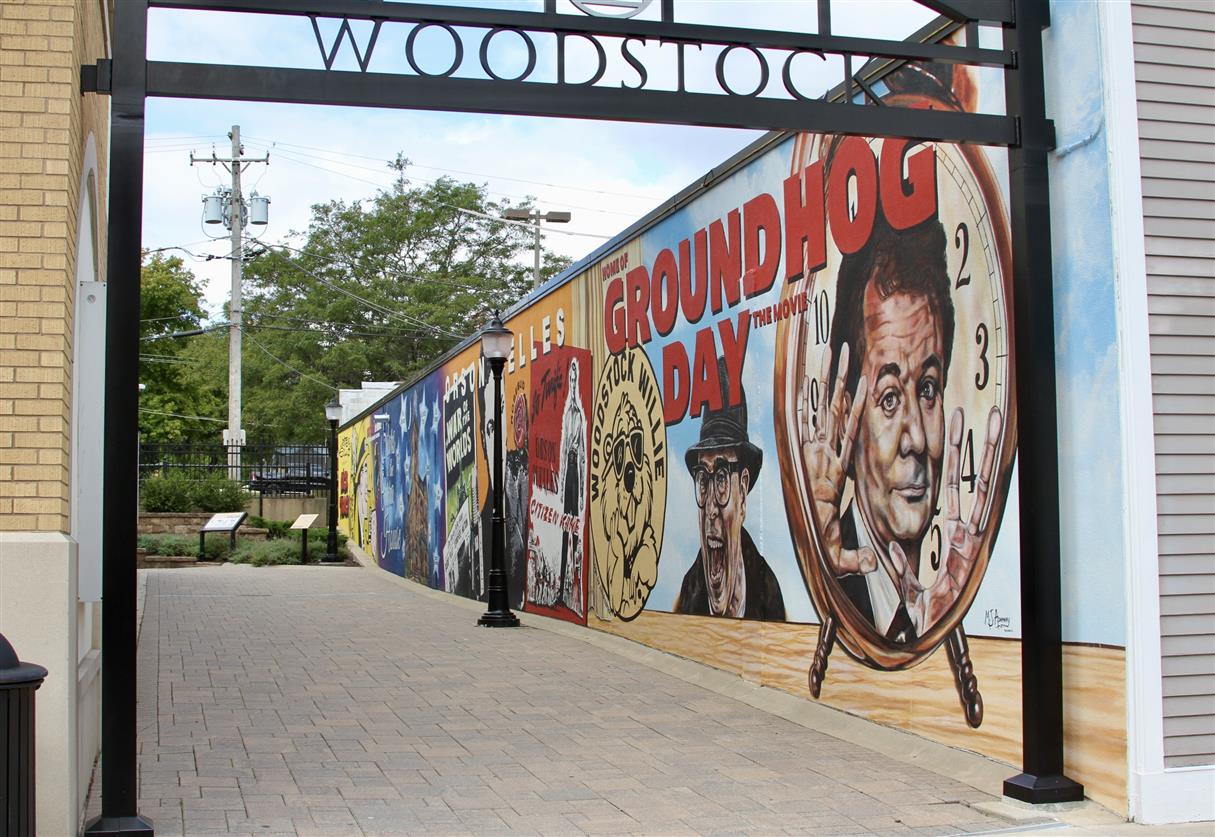Charlie penned a guest essay on this mural, and Woodstock:
My wife, Zoom, whose native tongue is Japanese, once asked me to define the word “quaint” — a deceptively simple request. As I attempted to answer, I found the meaning of quaint quite difficult to explain, as it is a subjective rather than a factual descriptor. How do you describe the feel of a place to a person who speaks English as a second language? I thought about it for a while and decided that it was best to show her, so I took my wife to a place where quaintness hangs thickly in the Midwestern air: Woodstock Square.
Woodstock, Illinois, is a far northwest suburb of Chicago (the second-to-last stop on the Union Pacific Northwest Metra line, Harvard being the last). It is an oasis of culture settled amidst the corn and soybean fields that fill the Illinois landscape outside the city of Chicago. The people of Woodstock are urbane. The community understands and appreciates how art, music and theater positively impact a town and its residents. Not only do they display a strong love of the arts, they advocate for them and create them. Woodstock is a city of cultural achievements, a city of doers. It’s in their history and in their blood, and the best of their efforts are displayed within the town square.
As my wife and I strolled through Woodstock Square in search of quaint, we thoughtfully absorbed the sights surrounding us: the Woodstock Opera House, the old courthouse (which is now an establishment of fine dining called The Public House), and a beautifully designed gazebo strategically placed in the center of the square. At one point, we happened upon a mural: an enormous painting that embodies the narrative of Woodstock’s rich cultural history.
Painted in 2017 by Rockford artist M.J. Adamany, the mural reads from left to right as a chronological record of Woodstock’s finest artistic achievements. It begins with Dick Tracy, the comic strip detective created in 1931 by Woodstock resident Chester Gould. This part of the mural is done in the bold and simple graphics of a panel in a comic book and is dominated by a profile of the lantern-jawed hero.
Adamany’s painting then transitions from the warm yellows of Tracy’s trench coat and fedora into the cool blues of a starry night over the Woodstock Opera House. Among those stars are painted some of the prominent names who have trod the boards within the historic building, including Oscar winners Paul Newman and Geraldine Page. The depiction of the opera house itself is immaculate and worth mentioning. Adamany used forced perspective to create the illusion of grandiose size on a small scale. It’s beautifully rendered in burnt neutral colors that lend it the appearance of leaping from the blue background and directly into the viewer’s world. It’s one of the strongest aspects of the mural.
As the eyes scan right, they come to rest upon the brilliance of Orson Welles, who called Woodstock his boyhood home. He cut his teeth at the age of 11 on the same opera house stage that hosts live performances to this very day. Sandwiched between a depiction of a newspaper headline for his infamous 1938 radio broadcast of “War of the Worlds” and a movie poster for his greatest triumph in film “Citizen Kane” is a black and white portrait of Welles: young, handsome and looking into a creative future others cannot see. The strength of the portrait lies in its size. Like Welles himself, it’s overwhelming, confrontational, bold and magnificent.
A depiction of the 1993 Bill Murray film “Groundhog Day” completes the narrative of the mural. Murray and the character “Needle Nose Ned” are painted in a realistic manner, which provides a contrast to the graphic stylizations of Dick Tracy and Orson Welles. The change in style of the portraits carries Woodstock from its culture-rich past into the present day of a city that still holds fast to the humanities and supports those who share them with the world.
Zoom and I found our definition of quaint in a town square in Woodstock, Illinois, and we discovered so much more in this culturally refined town. We found a collection of people who celebrate a past deeply embedded in the humanities and work toward a future of keeping public art alive and at the forefront of their community.





